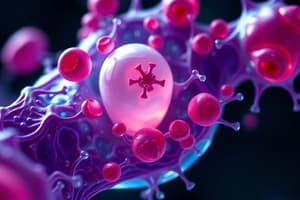Podcast
Questions and Answers
What is the main function of the nucleus in a cell?
What is the main function of the nucleus in a cell?
- Cell wall formation
- Energy production
- Protein synthesis
- Control center of the cell (correct)
Which organelle is responsible for generating energy for the cell through cellular respiration?
Which organelle is responsible for generating energy for the cell through cellular respiration?
- Lysosomes
- Endoplasmic Reticulum
- Mitochondria (correct)
- Golgi Apparatus
What is the function of the Golgi Apparatus?
What is the function of the Golgi Apparatus?
- Waste management
- Cell division
- Protein synthesis
- Protein modification, sorting, and packaging (correct)
What is the function of Lysosomes?
What is the function of Lysosomes?
Which organelle is involved in photosynthesis, pigment synthesis, and storage of nutrients?
Which organelle is involved in photosynthesis, pigment synthesis, and storage of nutrients?
What is the function of the Cytoskeleton?
What is the function of the Cytoskeleton?
What is the function of Vacuoles?
What is the function of Vacuoles?
Which organelle is involved in the formation of cilia and flagella?
Which organelle is involved in the formation of cilia and flagella?
Flashcards are hidden until you start studying
Study Notes
What are Cell Organelles?
- Specialized structures within a cell that perform specific functions
- Found in eukaryotic cells (plants, animals, fungi, and protists)
- Each organelle has a unique composition and function
Types of Cell Organelles:
- Nucleus
- Control center of the cell
- Contains genetic material (DNA)
- Regulates cell growth, division, and function
- Mitochondria
- Generates energy for the cell through cellular respiration
- Produces ATP (adenosine triphosphate)
- Found in both plant and animal cells
- Endoplasmic Reticulum (ER)
- Network of membranous tubules and cisternae
- Involved in protein synthesis, folding, and transport
- Two types: Rough ER (with ribosomes) and Smooth ER (without ribosomes)
- Ribosomes
- Small organelles found throughout the cytoplasm
- Site of protein synthesis
- Found in both prokaryotic and eukaryotic cells
- Lysosomes
- Membrane-bound sacs containing digestive enzymes
- Break down and recycle cellular waste and foreign substances
- Found in animal cells
- Golgi Apparatus
- Complex of flattened sacs and tubules
- Involved in protein modification, sorting, and packaging
- Plays a key role in cellular secretion
- Cytoskeleton
- Network of filaments that provide structural support and shape to the cell
- Composed of microtubules, microfilaments, and intermediate filaments
- Plastids
- Found in plant cells and some protists
- Involved in photosynthesis, pigment synthesis, and storage of nutrients
- Types: chloroplasts, chromoplasts, and amyloplasts
- Vacuoles
- Membrane-bound sacs that store water, salts, and other substances
- Help maintain cellular turgor pressure and pH balance
- Found in plant and fungal cells
- Centrioles
- Small, cylindrical organelles involved in the formation of cilia and flagella
- Also play a role in the separation of chromosomes during cell division
- Found in animal cells
Cell Organelles Overview
- Specialized structures within eukaryotic cells (plants, animals, fungi, and protists) that perform specific functions
- Each organelle has a unique composition and function
Nucleus
- Control center of the cell
- Contains genetic material (DNA)
- Regulates cell growth, division, and function
Mitochondria
- Generates energy for the cell through cellular respiration
- Produces ATP (adenosine triphosphate)
- Found in both plant and animal cells
Endoplasmic Reticulum (ER)
- Network of membranous tubules and cisternae
- Involved in protein synthesis, folding, and transport
- Two types: Rough ER (with ribosomes) and Smooth ER (without ribosomes)
Ribosomes
- Small organelles found throughout the cytoplasm
- Site of protein synthesis
- Found in both prokaryotic and eukaryotic cells
Lysosomes
- Membrane-bound sacs containing digestive enzymes
- Break down and recycle cellular waste and foreign substances
- Found in animal cells
Golgi Apparatus
- Complex of flattened sacs and tubules
- Involved in protein modification, sorting, and packaging
- Plays a key role in cellular secretion
Cytoskeleton
- Network of filaments that provide structural support and shape to the cell
- Composed of microtubules, microfilaments, and intermediate filaments
Plastids
- Found in plant cells and some protists
- Involved in photosynthesis, pigment synthesis, and storage of nutrients
- Types: chloroplasts, chromoplasts, and amyloplasts
Vacuoles
- Membrane-bound sacs that store water, salts, and other substances
- Help maintain cellular turgor pressure and pH balance
- Found in plant and fungal cells
Centrioles
- Small, cylindrical organelles involved in the formation of cilia and flagella
- Also play a role in the separation of chromosomes during cell division
- Found in animal cells
Studying That Suits You
Use AI to generate personalized quizzes and flashcards to suit your learning preferences.




